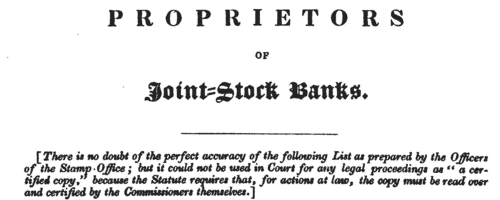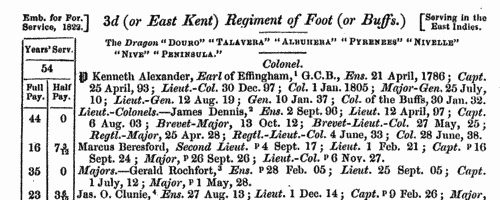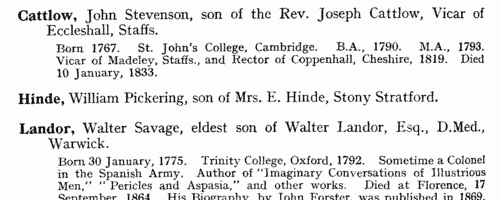Add this eBook to your basket to receive access to all 114 records. Our indexes include entries for the spelling gawler. In the period you have requested, we have the following 114 records (displaying 61 to 70): These sample scans are from the original record. You will get scans of the full pages or articles where the surname you searched for has been found. Your web browser may prevent the sample windows from opening; in this case please change your browser settings to allow pop-up windows from this site. Deaths, Marriages, News and Promotions
(1838)
Death notices and obituaries, marriage and birth notices, civil and military promotions, clerical preferments and domestic occurrences, as reported in the Gentleman's Magazine. Mostly from England and Wales, but items from Ireland, Scotland and abroad.
| Sample scan, click to enlarge

| Shareholders in the Leeds and West Riding Banking Company
(1838)
The provincial banks of England and Wales made annual returns to the Stamp Office of their proprietors or shareholders. These returns, registered in March 1838, from the 103 banks then in existence, contain the full names and addresses of about 30,000 shareholders. | Sample scan, click to enlarge

| Officers of the British Army
(1840)
The New Annual Army List, corrected to 7 February 1840, was published in London by Lieut. H. G. Hart. It lists all serving officers, first of all a list of General and Field Officers by rank from field marshal down to major; and then by regiment, including all ranks down to ensign, with paymasters, adjutants, quarter-masters, surgeons and assistant-surgeons. These lists are all annotated with dates of rank in the army and regiment, and with symbols indicating the officers present at Trafalgar (T), in the Peninsula or the South of France (P), and Waterloo (W). A superscript p indicates that the commission was purchased; an asterisk that it was temporary. The regiments and units are listed in order of precedence: Head Quarters staff; Life Guards; Horse Guards; 7 regiments of Dragoon Guards; 17 regiments of Dragoons; 98 regiments of Foot; the Rifle Brigade; two West India regiments of Foot; Ceylon Rifles; Royal African Colonial Corps; Cape Mounted Rifles; Royal Newfoundland Veterans; Royal Malta Fencibles; Recruiting Staff; Royal Artillery; Royal Engineers; Royal Marines; Commissariat; and the Medical Department. | Sample scan, click to enlarge

| Officers of the British Army holding British and Foreign Honours
(1840)
The New Annual Army List, corrected to 7 February 1840, was published in London by Lieut. H. G. Hart. These sections identify those officers who held various British and foreign honours. The lists are annotated with the name of the regiment, &c., and with symbols indicating the officers present in the Peninsula or the South of France (P), and Waterloo (W). The honours covered are Knights Grand Cross of the Bath (GCB); Knights Commanders of the Bath (KCB); Companions of the Bath (CB); Knights Grand Cross of St Michael and St George (GCMG); Knights Commanders of St Michael and St George (KCMG); Companions of St Michael and St George (CMG); Knights Grand Cross of the Royal Hanoverian Guelphic Order (GCH); Knights Commanders of the Royal Hanoverian Guelphic Order (KCH); Knights of the Royal Hanoverian Guelphic Order (KH); and a miscellany of honours from Austria, Bavaria, Belgium, France, Greece, Naples, Netherlands, Persia, Portugal, Prussia, Russia, Sardinia, Saxony, Spain, Sweden, Turkey, Tuscany and Wirtemburg.
| Sample scan, click to enlarge

| British Army officers
(1841)
The Royal Kalendar lists general and field officers of the British Army - five Field Marshals, 95 generals, 138 major-generals, 310 colonels, 637 lieutenant-colonels, 697 majors, in order of precedence according to year of precedence, and with the regiment indicated for each; then there are aides-de-camp to her Majesty queen Victoria; retired officers specially allowed to retain their ranks; and then the queen's land forces, set out regiment by regiment and battalion by battalion, naming the colonel, lieutenant-colonel and major for each, officers of the British garrisons, and of the Tower of London; and the officers of the Royal Regiment of Artillery (including the Field Train) and the Corps of Royal Engineers, by rank. | Sample scan, click to enlarge

| English lawyers
(1841)
The Royal Kalendar has a Law Department listing justices and officials of the High Court of Chancery; Masters in Chancery; Crown Office; Six Clerks Office; Register Office in Chancery Lane; Office of Reports and Entries; Affidavit Office; Hanaper Office; Examiner's Office; Petty Bag and Cursitors Office; Subpoena Office; Lord Chancellors officers; Vice-Chancellor's officers; officers to the Master of the Rolls; the Public Record Office at Rolls House; the Court of Bankruptcy; the Court for Relief of Insolvent Debtors; Court of Queen's Bench; Court of Common Pleas; Court of Exchequer; Exchequer Office of Pleas; Register of Deeds in the county of Middlesex; Queen's Sergeants and Counsel; Duchy Court of Lancaster; County Palatine of Lancaster; and County Palatine of Durham; Marshalsea and Palace-Court; Court of Westminster; with lists of the Lord Lieutenants and Sheriffs in England and Wales; and officials of the Inns of Court. There is also a list of the committee of the Law Society of the United Kingdom. | Sample scan, click to enlarge

| Insolvents
(1841)
Insolvency notices for England and Wales: insolvency often caused people to restart their lives elsewhere, so these are an important source for lost links | Sample scan, click to enlarge

| Insolvents
(1841)
Insolvency notices for England and Wales: insolvency often caused people to restart their lives elsewhere, so these are an important source for lost links | Sample scan, click to enlarge

| Officials in the British colonies
(1841)
The Royal Kalendar lists officials in the British colonies, arranged by continent: in Gibraltar, Malta, the United States of the Ionian Islands (Corfu, Cephalonia, Zante, St Maura, Ithaca, Cerigo and Paxo), and Heligoland in Europe; in Lower Canada, Upper Canada, Nova Scotia, New Brunwick, the Island of Prince Edward, Newfoundland, Jamaica, the Bahamas, Honduras, Barbadoes, St Vincent, Grenada, Tobago, Trinidad, St Lucia, Antigua, Montserrat, St Christopher's, Nevis, the Virgin Islands, Dominica, British Guiana, Berbice and Bermuda in the Americas; Ceylon, New South Wales, Van Diemen's Land, Western Australia and South Australia in Asia (and Australasia); Cape of Good Hope, St Helena, Mauritius, Sierra Leone and Gambia in Africa.
| Sample scan, click to enlarge

| Boys entering Rugby School
(1844)
This edition of Rugby School Register was published in 1933: the volume covering 1675 to 1857 contains 6480 entries, based on the original school admission registers, but elaborated with general biographical information wherever the editor was able to do so. The entries for the 17th and early 18th centuries are much less detailed than those for later years. The arrangement of the fullest entries was to give the boy's full name (surname first, in bold); whether eldest, second, &c., son; father's name and address as of when the boy entered school; the boy's age at entry and birthday; name of the house (in the school) to which he belonged; then a brief general biography; and date and place of death. | Sample scan, click to enlarge

|
Research your ancestry, family history, genealogy and one-name study by direct access to original records and archives indexed by surname.
|











